Identifying Transshipment Hubs in a Global Container Shipping Network: An Approach Based on Reinforced Structural Holes
Abstract
:1. Introduction
2. Literature Review
2.1. Transshipment Hubs and Their Maritime Connectivity
2.2. Methods Used to Identify Transshipment Hubs in Shipping Networks
3. Methodology and Data
3.1. Reinforced Structural Holes Method
3.2. The Louvain Algorithm
3.3. Data Collection
4. Empirical Results of the Analysis
4.1. Transshipment Hubs Identified by RSHs
4.2. Maritime Connectivity of Identified Hubs across Different Communities
5. Discussion: Implications for Policy Makers
6. Conclusions
Author Contributions
Funding
Institutional Review Board Statement
Informed Consent Statement
Data Availability Statement
Acknowledgments
Conflicts of Interest
References
- Ducruet, C.; Notteboom, T. The worldwide maritime network of container shipping: Spatial structure and regional dynamics. Glob. Netw. 2012, 12, 395–423. [Google Scholar]
- Li, Z.; Xu, M.; Shi, Y. Centrality in global shipping network basing on worldwide shipping areas. GeoJournal 2015, 80, 47–60. [Google Scholar]
- Zhang, Q.; Pu, S.H.; Luo, L.H.; Liu, Z.C.; Xu, J. Revisiting important ports in container shipping networks: A structural hole-based approach. Transp. Policy 2022, 126, 239–248. [Google Scholar]
- Dai, W.L.; Fu, X.W.; Yip, T.L.; Hu, H.; Wang, K. Emission charge and liner shipping network configuration—An economic investigation of the Asia-Europe route. Transp. Res. Part A Policy Pract. 2018, 110, 291–305. [Google Scholar]
- Kaluza, P.; Kolzsch, A.; Gastner, M.T.; Blasius, B. The complex network of global cargo ship movements. J. R. Soc. Interface 2010, 7, 1093–1103. [Google Scholar]
- Liu, C.L.; Wang, J.Q.; Zhang, H. Spatial heterogeneity of ports in the global maritime network detected by weighted ego network analysis. Marit. Policy Manag. 2018, 45, 89–104. [Google Scholar]
- Pan, J.J.; Bell, M.G.H.; Cheung, K.F.; Perera, S.; Yu, H. Connectivity analysis of the global shipping network by eigenvalue decomposition. Marit. Policy Manag. 2019, 46, 957–966. [Google Scholar]
- Girvan, M.; Newman, M.E.J. Community Structure in Social and Biological Networks. Proc. Natl. Acad. Sci. USA 2002, 99, 7821–7826. [Google Scholar]
- Tagawa, H.; Kawasaki, T.; Hanaoka, S. Evaluation of international maritime network configuration and impact of port cooperation on port hierarchy. Transp. Policy 2022, 123, 14–24. [Google Scholar]
- Ducruet, C.; Zaidi, F. Maritime constellations: A complex network approach to shipping and ports. Marit. Policy Manag. 2012, 39, 151–168. [Google Scholar]
- Zheng, J.F.; Qi, J.W.; Sun, Z.; Li, F. Community structure based global hub location problem in liner shipping. Transp. Res. Part E 2018, 118, 1–19. [Google Scholar]
- Rodrigue, J.P.; Ashar, A. Transshipment hubs in the New Panamax Era: The role of the Caribbean. J. Transp. Geogr. 2016, 51, 270–279. [Google Scholar]
- Corey, J.; Wang, Q.; Zheng, J.F.; Sun, Y.L.; Du, H.M.; Zhu, Z.H. Container transshipment via a regional hub port: A case of the Caribbean Sea region. Ocean Coast. Manag. 2022, 217, 105999. [Google Scholar]
- Liu, T.; Wang, H.Y. Evaluating the Service Capacity of Port-Centric Intermodal Transshipment Hub. J. Mar. Sci. Eng. 2023, 11, 1403. [Google Scholar]
- McCalla, R.J. Container transshipment at Kingston, Jamaica. J. Transp. Geogr. 2008, 16, 182–190. [Google Scholar]
- Notteboom, T.; Parola, F.; Satta, G. The relationship between transhipment incidence and throughput volatility in North European and Mediterranean container ports. J. Transp. Geogr. 2019, 74, 371–381. [Google Scholar]
- Wilmsmeier, G.; Monios, J.; Pérez-Salas, G. Port system evolution—The case of Latin America and the Caribbean. J. Transp. Geogr. 2014, 39, 208–221. [Google Scholar]
- Monios, J.; Wilmsmeier, G.; Adolf, K.Y.N. Port system evolution—The emergence of second-tier hubs. Marit. Policy Manag. 2019, 46, 61–73. [Google Scholar]
- Wang, Y.H.; Cullinane, K. Determinants of port centrality in maritime container transportation. Transp. Res. Part E Logist. Transp. Rev. 2016, 95, 326–340. [Google Scholar]
- Wan, C.; Zhao, Y.; Zhang, D.; Yip, T.L. Identifying important ports in maritime container shipping networks along the Maritime Silk Road. Ocean Coast. Manag. 2021, 211, 105738. [Google Scholar]
- Burt, R.S. Reinforced structural holes. Soc. Netw. 2015, 43, 149–161. [Google Scholar]
- De Meo, P.; Ferrara, E.; Fiumara, G.; Provetti, A. Generalized Louvain method for community detection in large networks. In Proceedings of the 11th International Conference on Intelligent Systems Design and Applications, Córdoba, Spain, 22–24 November 2011; pp. 88–93. [Google Scholar]
- Wang, L.H.; Zhu, Y.; Ducruet, C.; Bunel, M.; Lau, Y.Y. From hierarchy to networking: The evolution of the “twenty-first-century Maritime Silk Road” container shipping system. Transp. Rev. 2018, 38, 416–435. [Google Scholar]
- Kavirathna, C.A.; Kawasaki, T.; Hanaoka, S. Transshipment Hub Port Competitiveness of the Port of Colombo against the Major Southeast Asian Hub Ports. Asian J. Shipp. Logist. 2018, 34, 071–082. [Google Scholar]
- Jin, J.G.; Meng, Q.; Wang, H. Feeder vessel routing and transshipment coordination at a congested hub port. Transp. Res. Part B 2021, 151, 1–21. [Google Scholar]
- Chen, G.; Cheung, W.M.; Chu, S.C.; Xu, L. Transshipment hub selection from a shipper’s and freight forwarder’s perspective. Expert Syst. Appl. 2017, 83, 396–404. [Google Scholar]
- Cullinane, K.; Yap, W.Y.; Lam, J.S.L. The port of Singapore and its governance structure. Res. Transp. Econ. 2007, 17, 285–310. [Google Scholar]
- Wong, W.H.; Wong, E.; Mo, D.; Leung, L. Impact of cabotage relaxation in mainland China on the transshipment hub of Hong Kong. Marit. Econ. Logist. 2019, 21, 464–481. [Google Scholar]
- Tan, A.W.K.; Hilmola, O.P. Future of transshipment in Singapore. Ind. Manag. Data Syst. 2012, 112, 1085–1100. [Google Scholar]
- Fan, G.H.; Xie, X.K.; Chen, J.H.; Zheng, W.; Yu, M.Z.; Shi, J. Has China’s Free Trade Zone policy expedited port production and development? Mar. Policy 2022, 137, 104951. [Google Scholar]
- Wilmsmeier, G.; Hoffmann, J.; Sanchez, R.J. The impact of port characteristics on international maritime transport costs. Res. Transp. Econ. 2006, 16, 117–140. [Google Scholar]
- Parola, F.; Risitano, M.; Ferretti, M.; Panetti, E. The drivers of port competitiveness: A critical review. Transp. Rev. 2017, 37, 116–138. [Google Scholar]
- Rumaji; Adiliya, A. Port maritime connectivity in South-East Indonesia: A new strategic positioning for transshipment port of Tenau Kupang. Asian J. Shipp. Logist. 2019, 35, 172–180. [Google Scholar]
- Wang, Y.; Yeo, G.T. Transshipment hub port selection for shipping carriers in a dual hub-port system. Marit. Policy Manag. 2019, 46, 701–714. [Google Scholar]
- Tovar, B.; Wall, A. The relationship between port-level maritime connectivity and efficiency. J. Transp. Geogr. 2022, 98, 103213. [Google Scholar]
- Guerrero, D.; Nierat, P.; Thill, J.C. Visualizing maritime connectivity at national level: The case of LSBCI links of West European countries. Case Stud. Transp. Policy 2021, 9, 1818–1824. [Google Scholar]
- Ducruet, C.; Rozenblat, C.; Zaidi, F. Ports in multi-level maritime networks: Evidence from the Atlantic (1996–2006). J. Transp. Geogr. 2010, 18, 508–518. [Google Scholar]
- Wang, Y.H.; Cullinane, K. Traffic consolidation in East Asian container ports: A network flow analysis. Transp. Res. Part A Policy Pract. 2014, 61, 152–163. [Google Scholar]
- Wen, T.; Gao, Q.; Chen, Y.W.; Cheong, K.H. Exploring the vulnerability of transportation networks by entropy: A case study of Asia-Europe maritime transportation network. Reliab. Eng. Syst. Saf. 2022, 226, 108578. [Google Scholar]
- Freeman, L.C. Centrality in social networks conceptual clarification. Soc. Netw. 1979, 1, 215–239. [Google Scholar]
- Opsahl, T.; Agneessens, F.; Skvoretz, J. Node centrality in weighted networks: Generalizing degree and shortest paths. Soc. Netw. 2010, 32, 245–251. [Google Scholar]
- Zhang, X.; Zhang, W.; Lee, P.T.W. Importance rankings of nodes in the China Railway Express network under the Belt and Road Initiative. Transp. Res. Part A Policy Pract. 2020, 139, 134–147. [Google Scholar] [PubMed]
- Guedes, A.; Rebelo, J. River cruise holiday packages: A network analysis combined with a geographic information system framework. Tour. Manag. Perspect. 2021, 37, 100779. [Google Scholar]
- Burt, R.S. Structural Holes: The Social Structure of Competition; Harvard University Press: Cambridge, MA, USA, 1992. [Google Scholar]
- Hansen, D.L.; Shneiderman, B.; Smith, M.A.; Himeboim, I. Analyzing Social Media Networks with NodeXL: Insights from a Nonnected World, 2nd ed.; Morgan Kaufmann: Cambridge, MA, USA, 2020. [Google Scholar]
- Burt, R.S. Structural holes and good ideas. Am. J. Sociol. 2004, 110, 349–399. [Google Scholar]
- Burt, R.S.; Kilduff, M.; Tasselli, S. Social network analysis: Foundations and frontiers on advantage. Annu. Rev. Psychol. 2013, 64, 527–547. [Google Scholar]
- Lin, Z.; Zhang, Y.; Gong, Q.; Oksanen, A.; Ding, Y.A. Structural hole theory in social network analysis: A review. IEEE Trans. Comput. Soc. Syst. 2022, 9, 724–739. [Google Scholar]
- Burchard, J.; Cornwell, B. Structural holes and bridging in two-mode networks. Soc. Netw. 2018, 55, 11–20. [Google Scholar]
- Wang, P.; Deng, X.D.; Liu, Y.; Guo, L.; Zhu, J.; Fu, L.; Xie, Y.; Li, W.; Lai, J. A Knowledge Discovery Method for Landslide Monitoring Based on K-Core Decomposition and the Louvain Algorithm. ISPRS Int. J. Geo-Inf. 2022, 11, 217. [Google Scholar]
- Li, S.Y.; Song, W.B.; Zhao, C.; Zhang, Y.F.; Shen, W.M.; Hai, J.; Lu, J.W.; Xie, Y.S. An Anomaly Detection Method for Multiple Time Series Based on Similarity Measurement and Louvain Algorithm. Procedia Comput. Sci. 2022, 200, 1857–1866. [Google Scholar]
- Qin, J.D.; Li, M.X.; Liang, Y.Y. Minimum cost consensus model for CRP-driven preference optimization analysis in large-scale group decision making using Louvain algorithm. Inf. Fusion 2022, 80, 121–136. [Google Scholar]
- Xie, X.P.; Zhang, Y.; Zhang, C. Research on the division of container shipping network community based on Louvain Algorithm. Sci. J. Intell. Syst. Res. 2021, 3, 136–145. [Google Scholar]
- Hu, Y.H.; Zhu, D.L. Empirical analysis of the worldwide maritime transportation network. Physica A 2009, 388, 2061–2071. [Google Scholar]
- Barabási, A.L.; Albert, R. Emergence of scaling in random networks. Science 1999, 286, 509–512. [Google Scholar] [PubMed] [Green Version]
- Strogatz, S.H. Exploring complex networks. Nature 2001, 410, 268–276. [Google Scholar] [PubMed] [Green Version]
- Gouvernal, E.; Debrie, J.; Slack, B. Dynamics of change in the port system of the western Mediterranean. Marit. Policy Manag. 2005, 32, 107–121. [Google Scholar]
- UNCTAD. Port Liner Shipping Connectivity Index, Quarterly. 2023. Available online: https://unctadstat.unctad.org/wds/TableViewer/tableView.aspx (accessed on 18 April 2023).
- Xinhua Net. Shanghai Port Has over 300 International Shipping Routes with Connectivity Ranking First in the World. Available online: https://baijiahao.baidu.com/s?id=1725062391968398789&wfr=spider&for=pc (accessed on 18 April 2023).
- China Daily. Shanghai Port Continues to Rank First in Container Throughput Worldwide. 2022. Available online: http://www.chinadaily.com.cn/a/202201/04/WS61d39e9da310cdd39bc7edb2.html (accessed on 18 April 2023).
- Wang, L.H.; Lau, Y.Y.; Su, H.; Zhu, Y.; Kanrak, M. Dynamics of the Asian shipping network in adjacent ports: Comparative case studies of Shanghai-Ningbo and Hong Kong-Shenzhen. Ocean Coast. Manag. 2022, 221, 106127. [Google Scholar]
- Cheung, K.F.; Bell, M.G.H.; Pan, J.J.; Perera, S. An eigenvector centrality analysis of world container shipping network connectivity. Transp. Res. Part E 2020, 140, 101991. [Google Scholar]
- Yang, D.; Li, L.; Notteboom, T.E. Chinese investment in overseas container terminals: The role of investor attributes in achieving a higher port competitiveness. Transp. Policy 2022, 118, 112–122. [Google Scholar]
- Eidsaa, M.; Almaas, E. Investigating the relationship between k-core and s-core network decompositions. Phys. A 2016, 449, 111–125. [Google Scholar]
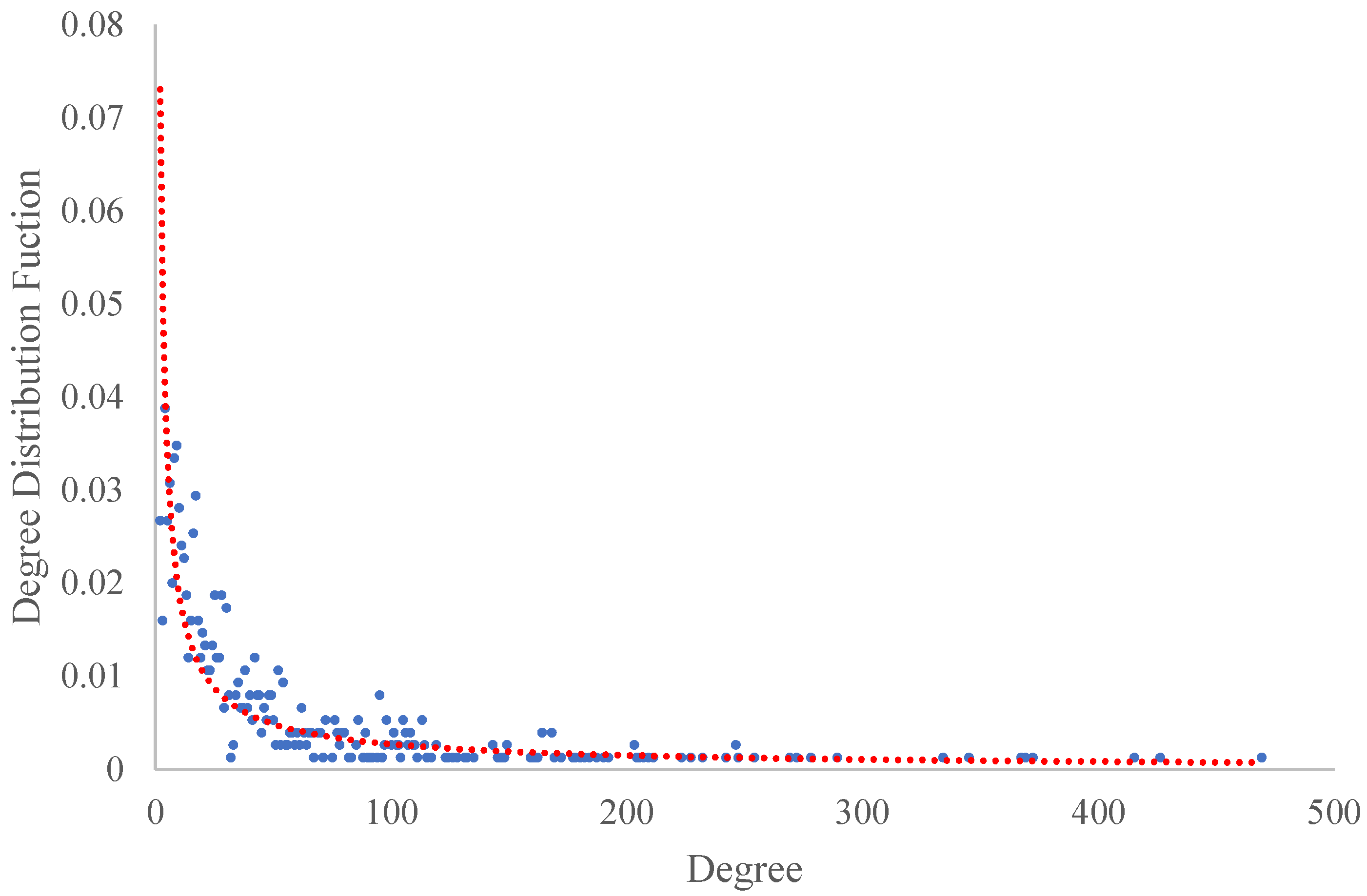
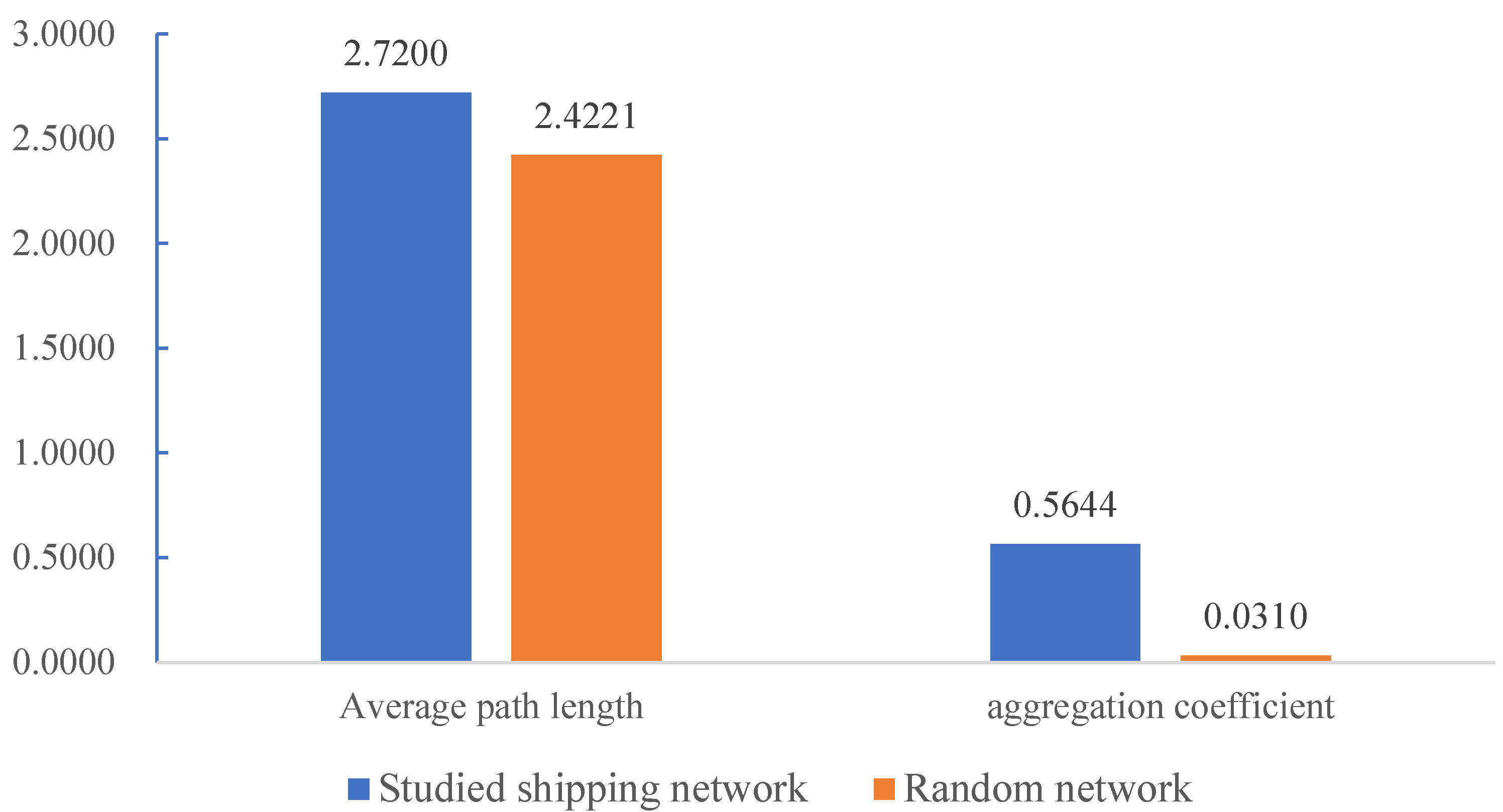
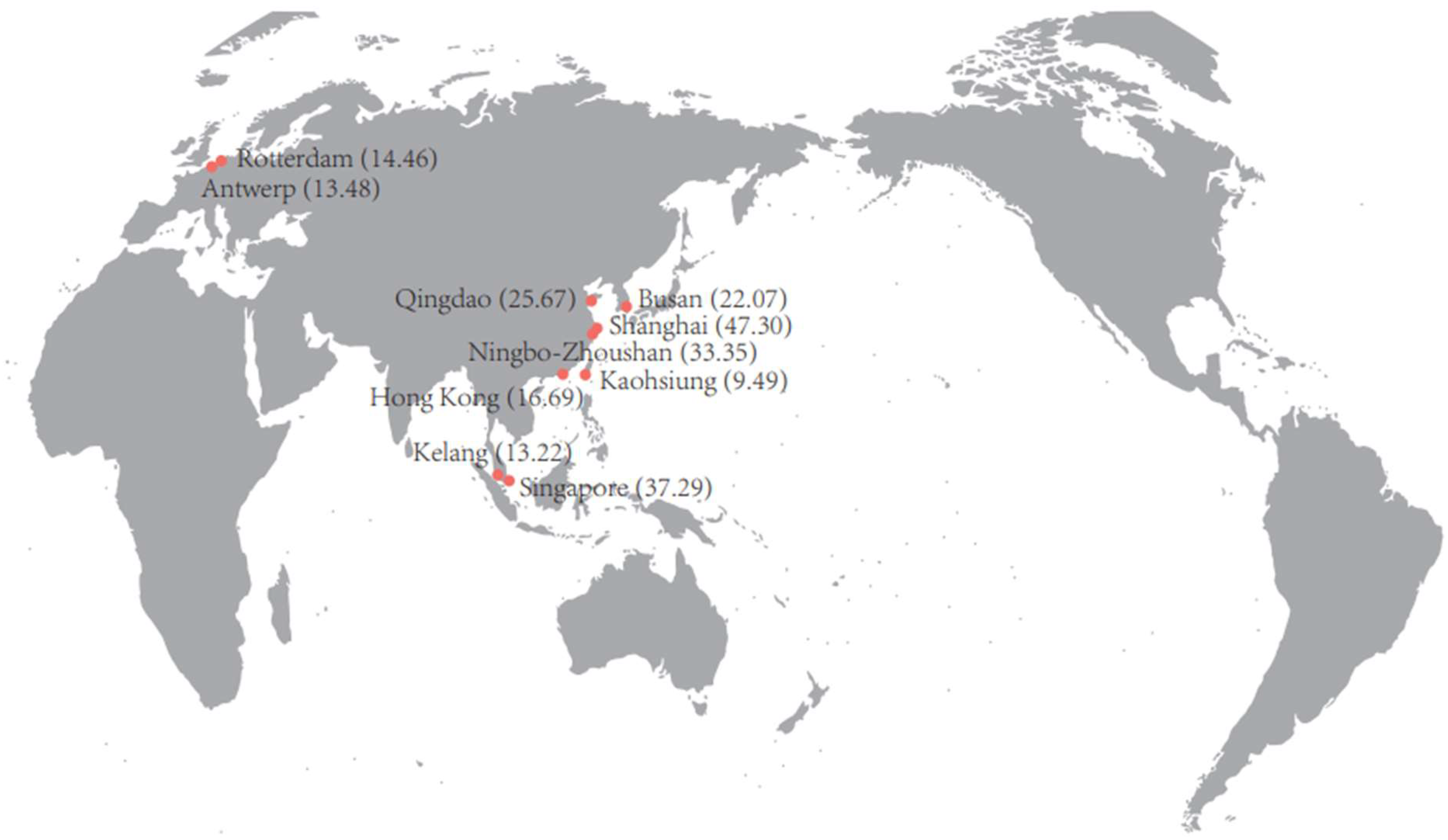
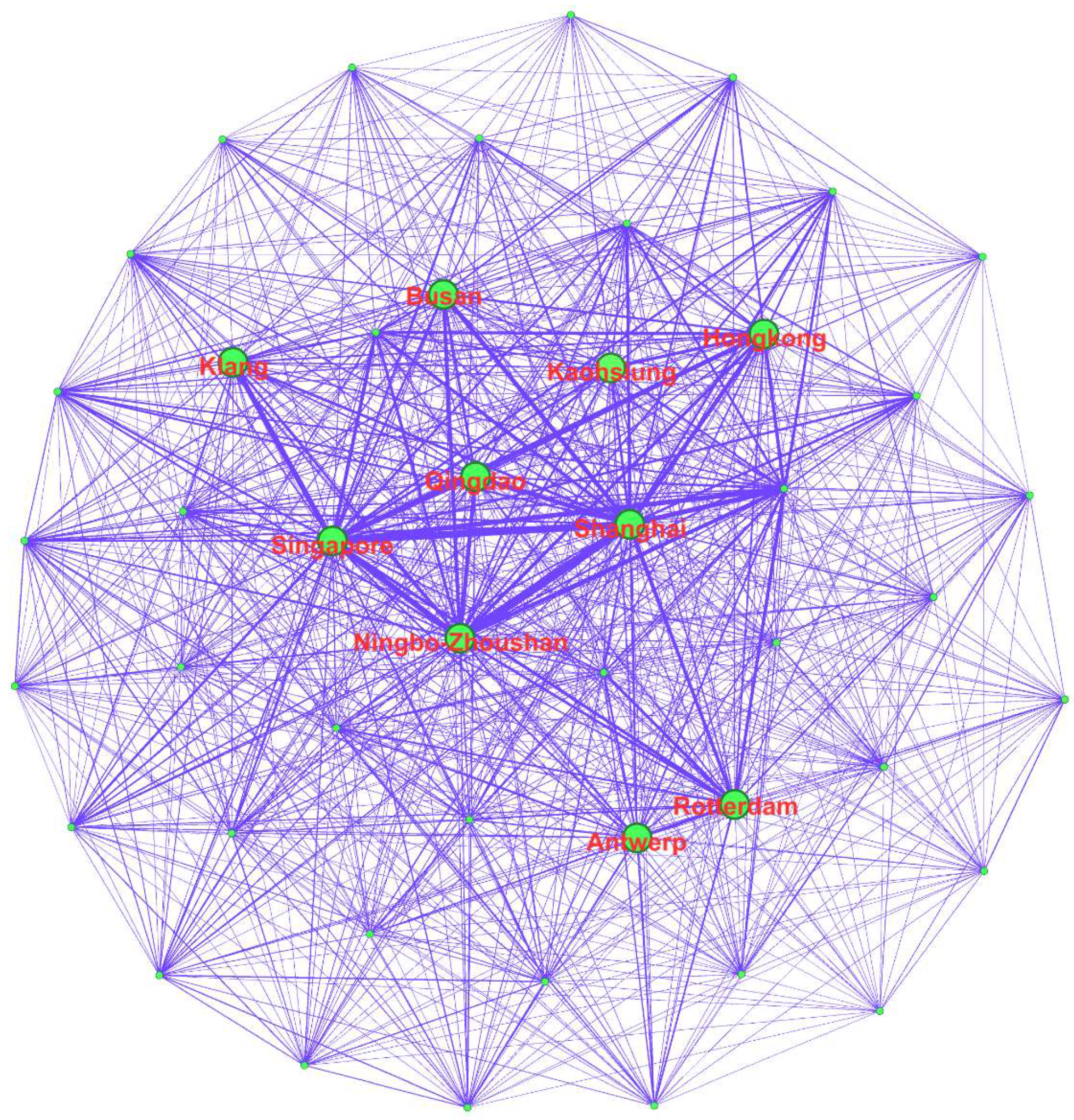
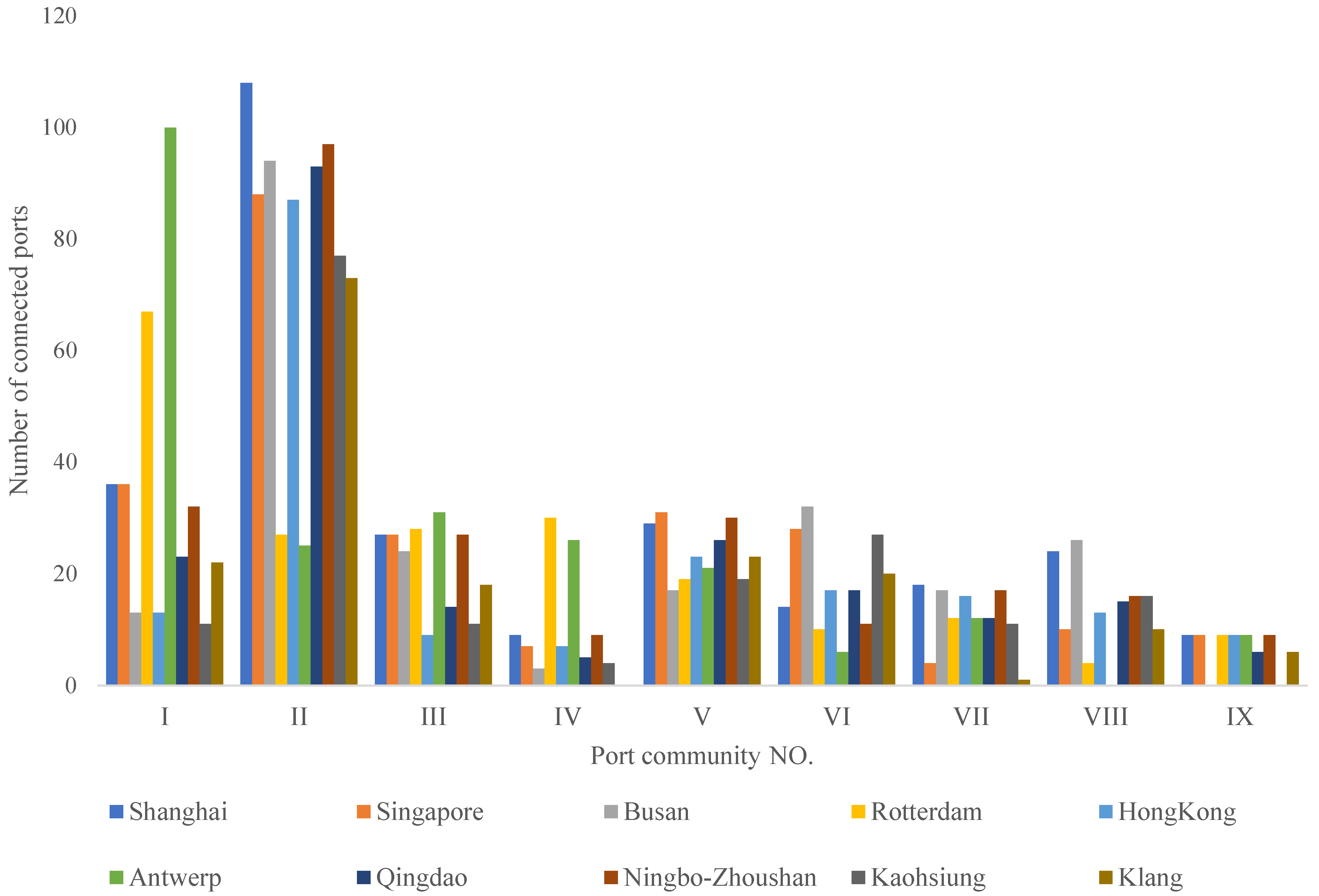
| Name of method | References | |
|---|---|---|
| Identify transshipment hubs at the global level | Betweenness centrality | [1,19] |
| Transshipment incidence | [12] | |
| Multiple linkage analysis | [38] | |
| Neighborhood-based centrality | [39] | |
| Identify transshipment hubs at the regional level | Structural hole theory | [3] |
| Eigenvalue decomposition | [7] | |
| Transshipment incidence | [15,16] | |
| Betweenness centrality | [20,37] |
| Rank | Port Name | Country | RSH Value |
|---|---|---|---|
| 1st | Shanghai | Mainland of China | 15,890.741 |
| 2nd | Singapore | Singapore | 15,668.165 |
| 3rd | Busan | South Korea | 14,274.507 |
| 4th | Rotterdam | Netherlands | 10,273.165 |
| 5th | Hong Kong | Mainland of China | 8263.750 |
| 6th | Antwerp | Belgium | 7714.973 |
| 7th | Qingdao | Mainland of China | 7301.486 |
| 8th | Ningbo-Zhoushan | Mainland of China | 6095.064 |
| 9th | Kaohsiung | Taiwan of China | 4876.624 |
| 10th | Klang | Malaysia | 4844.443 |
| Port Community | Number of Ports | Representative Ports |
|---|---|---|
| I | 153 | Rotterdam, Antwerp, Hamburg, Le Havre, Tanger Med, Algeciras, etc. |
| II | 149 | Shanghai, Hong Kong, Singapore, Busan, Kaohsiung, Tanjung Pelepas, etc. |
| III | 101 | Jeddah, Port Said, Haifa, Piraeus, Marseille, Marsaxlokk, etc. |
| IV | 78 | Houston, Port Everglades, Galveston, Philipsburg, Mariel, etc. |
| V | 60 | New York, Baltimore, Savannah, Boston, Colon, etc. |
| VI | 54 | Sydney, Melbourne, Tauranga, Auckland, Wellington, etc. |
| VII | 36 | San Antonio, Cristobal, Puerto Caldera, Guayaquil, Paita, etc. |
| VIII | 34 | Tokyo, Osaka, Nagoya, Kobe, etc. |
| IX | 24 | Santos, Rio Grande, Rosario, Itajai, etc. |
Disclaimer/Publisher’s Note: The statements, opinions and data contained in all publications are solely those of the individual author(s) and contributor(s) and not of MDPI and/or the editor(s). MDPI and/or the editor(s) disclaim responsibility for any injury to people or property resulting from any ideas, methods, instructions or products referred to in the content. |
© 2023 by the authors. Licensee MDPI, Basel, Switzerland. This article is an open access article distributed under the terms and conditions of the Creative Commons Attribution (CC BY) license (https://creativecommons.org/licenses/by/4.0/).
Share and Cite
Zhang, Q.; Pu, S.; Yin, M. Identifying Transshipment Hubs in a Global Container Shipping Network: An Approach Based on Reinforced Structural Holes. J. Mar. Sci. Eng. 2023, 11, 1585. https://doi.org/10.3390/jmse11081585
Zhang Q, Pu S, Yin M. Identifying Transshipment Hubs in a Global Container Shipping Network: An Approach Based on Reinforced Structural Holes. Journal of Marine Science and Engineering. 2023; 11(8):1585. https://doi.org/10.3390/jmse11081585
Chicago/Turabian StyleZhang, Qiang, Shunhao Pu, and Ming Yin. 2023. "Identifying Transshipment Hubs in a Global Container Shipping Network: An Approach Based on Reinforced Structural Holes" Journal of Marine Science and Engineering 11, no. 8: 1585. https://doi.org/10.3390/jmse11081585
APA StyleZhang, Q., Pu, S., & Yin, M. (2023). Identifying Transshipment Hubs in a Global Container Shipping Network: An Approach Based on Reinforced Structural Holes. Journal of Marine Science and Engineering, 11(8), 1585. https://doi.org/10.3390/jmse11081585






